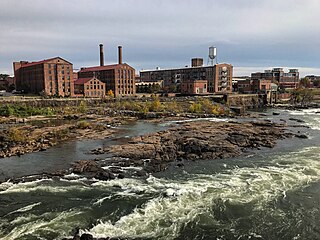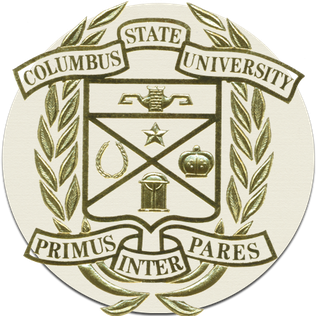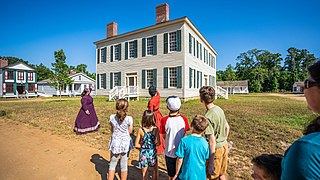
John Stith Pemberton was an American pharmacist and Confederate States Army veteran who is best known as the inventor of Coca-Cola. In May 1886, he developed an early version of a beverage that would later become Coca-Cola, but sold its rights to the drink shortly before his death in 1888.

Eufaula is the largest city in Barbour County, Alabama, United States. As of the 2010 census the city's population was 13,137.

Columbus is a consolidated city-county located on the west-central border of the U.S. state of Georgia. Columbus lies on the Chattahoochee River directly across from Phenix City, Alabama. It is the county seat of Muscogee County, with which it officially merged in 1970. Columbus is the second most populous city in Georgia, and fields the state's fourth-largest metropolitan area. At the 2020 census, Columbus had a population of 206,922, with 328,883 in the Columbus metropolitan area. The metro area joins the nearby Alabama cities of Auburn and Opelika to form the Columbus–Auburn–Opelika Combined Statistical Area, which had an estimated population of 486,645 in 2019.

Columbus State University is a public university in Columbus, Georgia. Founded as Columbus College in 1958, the university was established and is administered by the Board of Regents of the University System of Georgia.

Pasaquan is a 7-acre (28,000 m2) compound near Buena Vista, Georgia. It was created by an eccentric folk artist named Eddie Owens Martin (1908–1986), who called himself St. EOM. An internationally renowned art site, it consists of six major structures including a redesigned 1885 farmhouse, painted concrete sculptures, and 4 acres (16,000 m2) of painted masonry concrete walls. In September 2008, Pasaquan was accepted for listing in the National Register of Historic Places. Pasaquan was restored by the Kohler Foundation and Columbus State University between 2014 and 2016.

WGBP-TV is a television station licensed to Opelika, Alabama, United States, broadcasting the digital multicast network NBC LX Home and owned by CNZ Communications, LLC. WGBP-TV is broadcast from a two-site distributed transmission system, with transmitters at Cusseta and Warm Springs, Georgia.

Historic Westville is a history museum representing a 19th-century Georgia town in Columbus, Georgia, United States.

Callaway Resort & Gardens is a 2,500-acre (1,000 ha) resort complex located near Pine Mountain in Harris County, Georgia, 18 miles (29 km) from LaGrange, Georgia. The world's largest azalea garden, this destination draws over 750,000 visitors annually. Callaway Gardens was ranked as Best Georgia Attraction in 2018 by USA Today.

Total System Services, Inc., is an American financial technology company headquartered in Columbus, Georgia. In 2019, TSYS was merged into Global Payments Inc. TSYS is the largest third-party payment processor for issuing banks in North America, with a 40% market share, and one of the largest in Europe. It provides payment processing services, merchant services and related payment services. It also provides reloadable prepaid debit cards and payroll cards, and demand deposit accounts to the underbanked.

The National Civil War Naval Museum, located in Columbus, Georgia, United States, is a 40,000-square-foot (3,700 m2) facility that features remnants of two Confederate States Navy vessels. It also features uniforms, equipment and weapons used by the United States (Union) Navy from the North and the Confederate States Navy forces. It is claimed to be the only museum in the nation that tells the story of the two navies during the Civil War.

Horace King was an African-American architect, engineer, and bridge builder. King is considered the most respected bridge builder of the 19th century Deep South, constructing dozens of bridges in Alabama, Georgia, and Mississippi. King was born into slavery on a South Carolina plantation in 1807. A slave trader sold him to a man who saw something special in Horace King. His owner, John Godwin taught King to read and write as well as how to build at a time when it was illegal to teach slaves. King worked hard and despite bondage, racial prejudice and a multitude of obstacles, King focused his life on working hard and being a genuinely good man. King built bridges, warehouses, homes, and churches. Horace King became a highly accomplished Master Builder and he emerged from the Civil War as a legislator in the State of Alabama. Affectionately known as Horace “The Bridge Builder” King and the "Prince of Bridge Builders," he also served his community in many important civic capacities."

The Columbus Historic Riverfront Industrial District encompasses one of the most significant assemblages of 19th-century waterpowered mill technology in the American South. A National Historic Landmark District, it includes five historic industrial complexes with elements surviving as far back as the 1830s, located in four separate areas along the eastern bank of the Chattahoochee River in Columbus, Georgia. It was declared a National Historic Landmark in 1978.

The Chattahoochee RiverWalk is a 22-mile walking and biking area along the Chattahoochee River in Columbus, Georgia, United States. The trail is paved with asphalt, concrete, or brick. Due to the RiverWalk bike path, Columbus has been listed by the League of American Bicyclists as one of the forty most Bicycle Friendly Communities in the United States.

Downtown Columbus, Georgia, also called "Uptown", is the central business district of the city of Columbus, Georgia. The commercial and governmental heart of the city has traditionally been toward the eastern end of Downtown Columbus, between 10th Street and 1st Avenue. Recent developments, particularly between Broadway and 2nd Avenue, have expanded the boundaries of the "central" part of the neighborhood. The term "Downtown Columbus" can also mean this smaller, more commercial area, particularly when used in the context of the city's nightlife and restaurants.

Columbus Historic District in Columbus, Georgia is a historic district that was listed on the National Register of Historic Places in 1969. Its area was increased in 1988. The original district included 20 city blocks and nine partial city blocks, and was bounded by the Chattahoochee River on the west, Ninth Street on the north, Fourth Avenue on the east, and Fourth Street on the south.
Chattahoochee Valley Community College is a public community college in Phenix City, Alabama. It serves residents of Russell County and parts of Bullock, Lee, Macon, and Barbour Counties, as well as the Columbus, Georgia metropolitan area. Since 1975 it has shared its campus with Troy University's Phenix City Campus.
The following is a timeline of the history of the city of Columbus, Georgia, US.

The Chattahoochee Valley Libraries (CVL) are a consortium of public libraries serving the Greater Columbus area of Georgia, United States. The library system consists of seven branches over four counties, Muscogee, Chattahoochee, Marion, and Stewart, Georgia. The headquarters of the library system is the Columbus Public Library located in the county seat, Columbus.

The Lion House, also known as the Hoxey–Cargill House, is a historic building in Columbus, Georgia. The building, located in the High Uptown Historic District, was built in the 1840s and was added to the National Register of Historic Places in 1972.



















